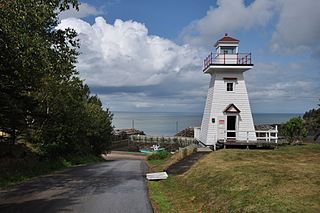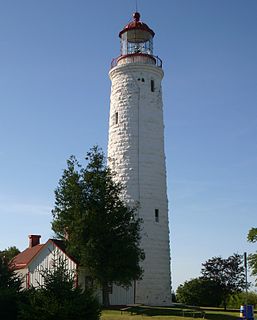
Port Royal is a Canadian rural community in Annapolis County, Nova Scotia.

Granville Centre is a rural Canadian community located in Annapolis County on the north shore of the Annapolis River in western Nova Scotia. The community is named after John Carteret, 2nd Earl Granville.

Carleton Corner is a community in the Canadian province of Nova Scotia, located in Annapolis County adjacent to Bridgetown. It is a designated place with a population of 106 in 2016. It is on Nova Scotia Route 201.

Deep Brook is a community in the Canadian province of Nova Scotia, located in Annapolis County. It is situated on the south shore of the Annapolis Basin and is on Nova Scotia Trunk 1.

Upper Clements is a community in the Canadian province of Nova Scotia, located in Annapolis County. It is on Nova Scotia Trunk 1 on the eastern side of the Annapolis Basin. The town is the site of Upper Clements Park and Upper Clements Provincial Park.

Granville Ferry is a village in the Canadian province of Nova Scotia, located in Annapolis County. Granville Ferry is located directly across the Annapolis River from Annapolis Royal, Nova Scotia. It was the northern terminus for ferries running across the river. Granville Ferry was a major shipbuilding centre in the Golden Age of Sail. The village was also home to Bessie Hall, a notable female mariner in the 19th century. The community is named after John Carteret, 2nd Earl Granville. Its population at the 2016 census was 110, a decline of 22.5% since 2011.

Lequille is a community in the Canadian province of Nova Scotia, located in Annapolis County. It is on Nova Scotia Trunk 8 at the foot of the South Mountain, midway between Annapolis Royal to the northwest and Highway 101 to the south, approximately 3 km (1.9 mi) distant. As of 2016 its population was 222, a decline of 3.1% since 2011.

Victoria Beach is a small community in the Canadian province of Nova Scotia, in Annapolis County. It is on the shore of Digby Gut, a narrow channel connecting the Bay of Fundy with the Annapolis Basin.

Maitland Bridge is a community in the Canadian province of Nova Scotia, located in Annapolis County on Trunk 8 which crosses the Mersey River here. It is named after General Sir Peregrine Maitland, Lieutenant Governor of Nova Scotia from 1828 to 1834. The entrance to Kejimkujik National Park is at Maitland Bridge.

Belleisle is a community in the Canadian province of Nova Scotia, located in Annapolis County. It is on Nova Scotia Trunk 1, on the north side of the Annapolis River.

Albany Cross is a community in the Canadian province of Nova Scotia, located in Annapolis County. It is likely named for Albany, New York. Albany Community Church was dedicated in 1875 as a Baptist church and is now a municipally registered heritage building.

Moschelle is a community in the Canadian province of Nova Scotia, located in Annapolis County. It is on the south shore of the Annapolis River, on Nova Scotia Route 201.

Hampton is a community in the Canadian province of Nova Scotia, located in Annapolis County. It overlooks the Bay of Fundy and a lighthouse was built here in 1911.

Port George is a seaside community in the Canadian province of Nova Scotia, located in Annapolis County. It is a former port situated on the Bay of Fundy, 11 km north of Middleton, Nova Scotia just across North Mountain. It sits on the 45th parallel north.

Karsdale is a community in the Canadian province of Nova Scotia, located in Annapolis County. It is situated on the west bank of the Annapolis Basin. The community is named after Sir William Williams, 1st Baronet, of Kars.

Port Wade is a community in the Canadian province of Nova Scotia, located in Annapolis County. It is situated at the foot of North Mountain on the shore of the Annapolis Basin. An earlier French name was Pree Bourgeois and it was later known as West Ferry until 1905 when it was named after Fletcher Bath Wade.

Greenland is a community in the Canadian province of Nova Scotia, located in Annapolis County and is at an elevation of approximately 180m. It was settled in the 1780s by disbanded German troops following the American Revolutionary War.

West Paradise is a community in the Canadian province of Nova Scotia, located in Annapolis County. It is located in the Annapolis Valley along Nova Scotia Route 201 across the Annapolis River from Paradise.

The Digby Gut is a narrow channel connecting the Bay of Fundy with the Annapolis Basin. The town of Digby, Nova Scotia is located on the inner portion of the western side of the Gut. The eastern entrance is marked by the Point Prim Lighthouse. Strong tidal currents, numerous rocky ledges, frequent fogs and unpredictable winds make it a dangerous passage requiring a pilot or local knowledge. Tide flows create 5 knot tidal currents and create numerous whirlpools and eddies. The gut is about a half nautical mile in width and bordered by high rocky cliffs. It marks a break in the North Mountain ridge along the Annapolis Valley and is the eastern end of Digby Neck. Digby Gut had its origins as the northern terminus of the ancient Bear River, part of which is now a drowned river valley.

Low Point Lighthouse is a historic Canadian lighthouse marking the eastern entrance to Sydney Harbour at New Victoria, Nova Scotia, near New Waterford, Nova Scotia. This is one of the earliest and most important light stations of Nova Scotia, one of the first dozen beacons in Nova Scotia to be lit to guide mariners, a classic red-and-white lighthouse still operated by the Canadian Coast Guard.










